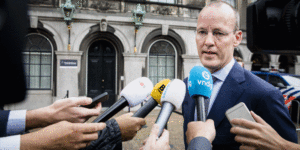Het klimaatvirus blijft zich nog steeds maar verspreiden.

Klaas Knot, President Nederlandsche Bank.
In mijn perceptie vertegenwoordigden presidenten van centrale banken vleesgeworden soliditeit en nuchterheid. Na lezing van onderstaand bericht ben ik weer een illusie armer geworden. Daaruit blijkt dat ook zij zich laten meeslepen door klimaathysterie.
Onder de titel, ‘Global Warming is a Central Bank Issue’, schreef Ferdinando Giugliano onlangs een interessante bijdrage voor Bloomberg. Ik pik een aantal elementen uit zijn artikel.
Central bankers have been dubbed “masters of the universe” for the tools and powers they have acquired since the financial crisis. Some of them now want to play a more active role in the fight against climate change.
Monetary authorities are right to be mindful of the way in which climate risk affects their mandate to ensure price stability and guard financial stability. But that is different from seeking to promote the shift to a “greener” economy, which is the role of government.
Last week, central bank governors from the U.K., France and the Netherlands met in Amsterdam to discuss how to adapt regulation to the risks posed by climate change. Together with five other institutions (from China, Germany, Mexico, Singapore and Sweden), these central banks have formed the “Network for Greening the Financial System” (NGFS). This group has two objectives: sharing and identifying best practices in the supervision of climate-related risks, and enhancing the role of the financial sector in mobilizing “green” financing.
The first is entirely reasonable and consistent with the central banks’ traditional role. As Francois Villeroy de Galhau, governor of the Bank of France, said in a speech at the conference, “Climate stability is one of the determinants of financial stability.” It is only right that financial supervisors take an interest in what is going on.
Dit is een glibberige gedachtegang. Wat is klimaatstabiliteit gegeven het feit dat het klimaat altijd verandert? Verandering is de norm! En gaat het niet wat ver dat financiële toezichthouders hun werkterrein gaan uitbreiden met iets waar zij niet voor zijn opgeleid en geen kaas van blijken te hebben gegeten?
The clearest example concerns the regulation of insurers: Climate change has made extreme weather events such as hurricanes more frequent. Regulators must ensure that the industry updates its models and sets aside enough capital to deal with these growing climate-related risks.
Daar istie weer! Het bekende sprookje van de toename van weersextremen. Als het VN–klimaatpanel (IPCC) niet alarmistisch genoeg is, dan doet de politiek er een schepje bovenop om de klimaathysterie aan te jagen! Maar het IPCC heeft geen trends kunnen ontdekken in weersextremen en al helemaal geen verband met CO2.
To do so, central bankers may need to extend the supervisory horizon beyond their usual time span. Climate change may only pose a threat for the balance sheet some years down the road, but these risks should be assessed now. Villeroy de Galhau argued in his speech that the financial sector should move towards “a compulsory transparency requirement,” so that companies are forced to provide a snapshot of their climate-related risks. It’s an idea supervisors around the world should embrace.
Men mag aannemen dat centrale bankiers economisch geschoold zijn. Dan zouden zij toch uit de economische geschiedenis moeten weten dat de periode na het einde van de laatste kleine ijstijd (rondom 1850), die werd gekenmerkt door een geringe stijging van de gemiddelde wereldtemperatuur, de grootste welvaartsstijging ooit in de menselijke geschiedenis heeft gekend. De meer recente – geringe – stijging van de temperatuur heeft tot op heden per saldo positieve effecten gehad, zoals uit de mainstream economische milieuliteratuur blijkt. Er zijn geen schadelijke effecten te verwachten van de huidige quasi–stabilisatie van de gemiddelde wereldtemperatuur. Dat geldt echter helaas niet voor het afgesproken klimaatbeleid waarvan de kosten alleen al voor Nederland door minister Wiebes op 1 – 3% van het BNP werden geschat en door Climategate.nl op € 580 miljard voor een reductie van 15% van de nationale CO2–uitstoot, terwijl volgens het regeerakkoord rond 2030 49% – dus meer dan drie maal zo veel – zou dienen te worden bespaard. En wat is het klimaateffect daarvan? Dat is zó klein dat het niet meetbaar is.
Is het voorstelbaar dat deze plannen zullen worden gerealiseerd? Ik waag het te betwijfelen. Ik zie veel beren op de weg en veel ‘climate–related risks’ – herstel: ‘climate–policy–related risks.’
The idea that central banks should promote “green investment” — which the central bank group also endorses – is more problematic. For a start, the goal could conflict with the main central bank objective of preserving financial stability. For example, if a bank loan to a company which produces renewable energy is given a lower risk weight than now just because it is “green,” then supervisors would be giving banks the wrong incentive to load up on such assets. …
The problem with this idea is that it requires more speculation than central banks should be tasked with. What if this shift to a low-carbon economy happens more slowly than anticipated or does not happen at all? Another problem is deciding where to draw the line when it comes to central banks nudging economic actors along …
In “promoting green investment” a central bank would risk overstepping its mandate. By choosing to treat bank loans differently depending on their green credentials, a central bank could also be accused of distorting competition in the economy. …
Aldus Ferdinando Giugliano.
Lees verder hier.
Het lijkt mij onwenselijk dat centrale banken op bovengeschetste wijze hun mandaat proberen op te rekken. Aan hun huidige taken, waaronder het beheerst afbouwen van de schuldenberg, hebben zij al hun handen vol.


0 reacties :
Een reactie posten